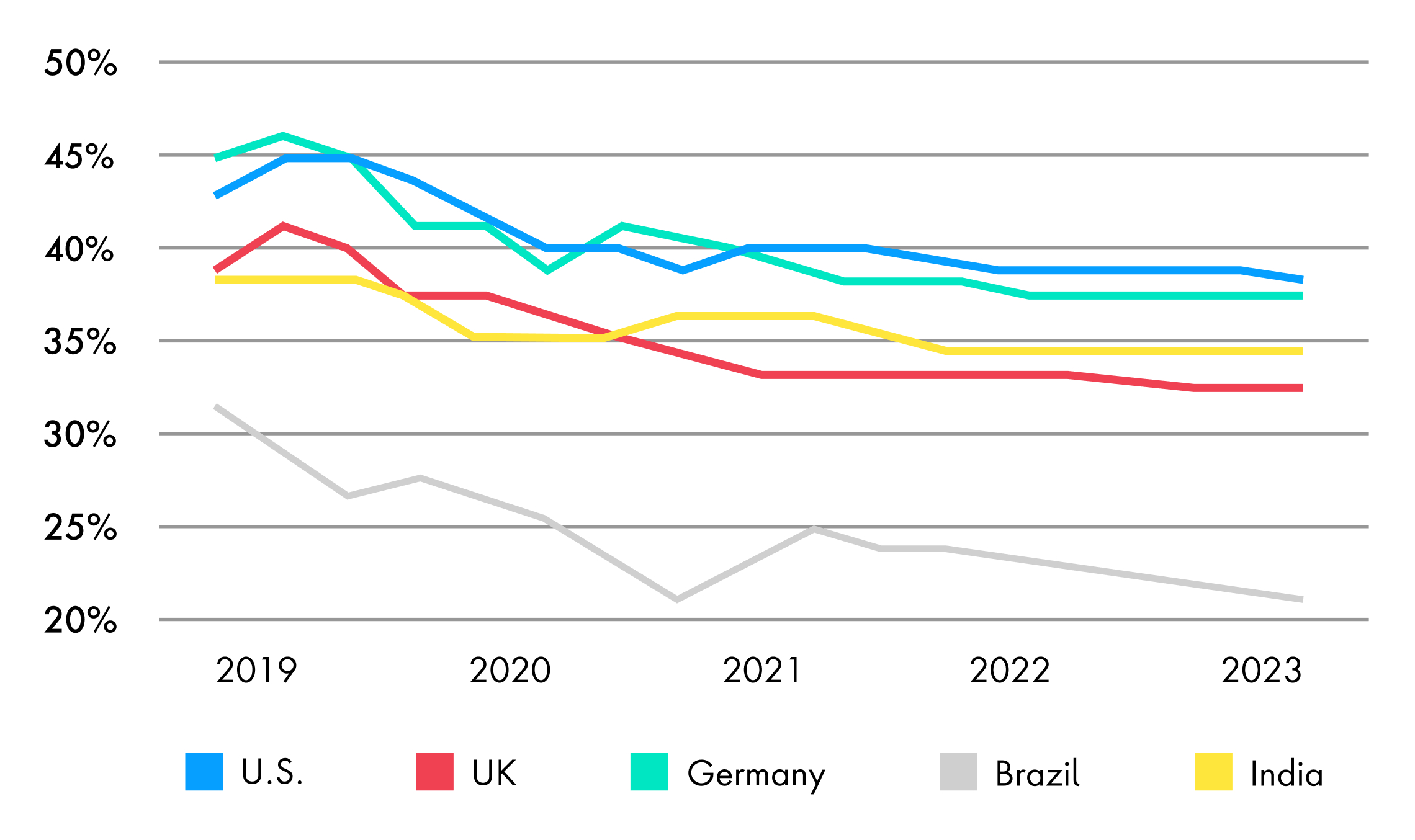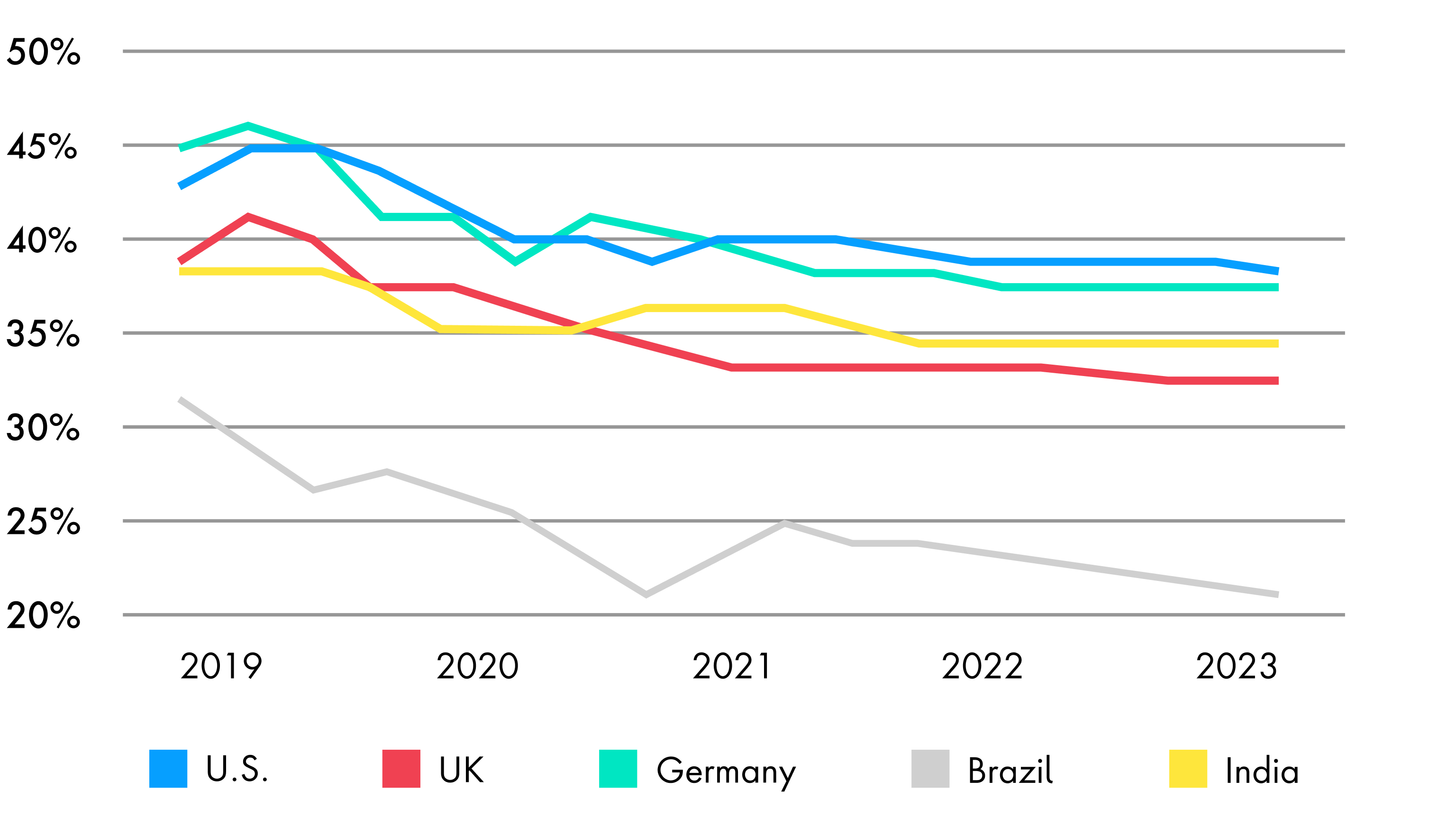What issue can we solve for you?
Type in your prompt above or try one of these suggestions
Suggested Prompt


8 Trends Accelerating the Future of E-Commerce in 2025
Which trends really matter? Our industry experts highlight the ones that every organization engaging in e-commerce needs to know—and what they can do to stay ahead.


The race toward seamless, hyper-personalized shopping experiences will shift into high gear in 2025.
However, significant economic headwinds will continue to drive consumers’ hunt for value after years of inflation. Reduced disposable income, mounting consumer debt and still elevated interest rates are the main factors preventing consumers from loosening their purse strings.
How can brands prepare for the year ahead? Everyone will be investing in artificial intelligence, seamless customer experiences and digital business transformation. But developing a comprehensive strategy that incorporates all of these investments will be key to maintaining a competitive advantage in the e-commerce landscape.
In this article, we’ll explore the top eight trends changing the e-commerce landscape, based on global consumer research and insight from our retail industry experts Sudip Mazumder and Guy Elliott.


1. Generative AI, zero-click search turns e-commerce into a conversation
Despite the fast rise of generative AI technology—particularly large language models (LLMs), through tools like ChatGPT—many organizations are left wondering which use cases provide the most value for their needs, whether or not customers will engage with it on search engines and, frankly, what they need to change to avoid getting left behind.
In 2025, many e-commerce websites will continue rolling out generative or conversational search tools. Homes & Villas by Marriott Bonvoy, for instance, partnered with Publicis Sapient to develop an AI-powered search tool that uses natural language to match users with accommodation options based on their criteria.
How are consumers responding to the rapid commercial adoption of generative AI? Approximately 27 percent of consumers overall are excited about generative AI’s ability to improve real-time deal comparison and overall search results, according to a Publicis Sapient global consumer survey.
While this shift to generative and intent based search may take longer to infiltrate brand websites, almost half (43 percent) of consumers that have used a generative AI tool expect that brands will employ the technology to improve their customer experience. Organizations that experiment with the generative style in 2025 will create a competitive advantage.


2. Media networks will continue to drive incremental growth
It’s time for media networks to get more personalized and, surprisingly, consumers agree. Retail media has reached $30 billion in revenue faster than both search and social, according to Luma Partners, and continues to fill a market need for consumer packed goods and branded manufacturers.
Reuters projects that by 2028, revenue from retail media networks will account for 15.4 percent of all revenue from ads, eclipsing television as an advertising platform.
It annoys me receiving online ads based on my search history


Statista Consumer Insights Global Survey: Which of these statements about online advertising do you agree with? (multi-pick), all respondents
According to data from Statista, consumers still find targeted advertising annoying. At the same time, their expectation and preference for customized e-commerce advertising is only going to increase.
As an example of this, in most cases, media network advertising that targets loyalty program segments is only differentiated based on recent spend and/or points accumulation. An incredibly diverse group of customers are all hit with the same blanket offerings and promotions, i.e., a “spray and pray” approach.
While the contact information that these loyalty members provide is valuable on its own, media networks that further segment their promotional offers within their loyalty programs receive higher engagement and return business.


Guide to Next 2025
What challenges and opportunities will emerge in 2025? Our experts offer industry-specific predictions and guidance for what awaits businesses in the year ahead.


3. Secondhand marketplaces compete for consumer attention—and offer a new entry point for traditional commerce players
With cost-of-living increases and sustainable purchasing habits on the rise, secondhand marketplaces, rental platforms and resale are going to accelerate more than ever before.
According to a survey of consumers in the United Kingdom, over four in 10 (44 percent) buy more secondhand items than they did a year ago, while a further 57 percent say their re-commerce shopping behavior has remained consistent.
While third-party C2C marketplaces like ThredUp, Vinted, eBay and even Facebook Marketplace have thus far dominated the secondhand market, new B2C and even B2B marketplaces are on the rise.
From Walmart’s B2B liquidation auctions to their B2C marketplace, or Lululemon’s “Like New” resale website, retailers will need to experiment with the right price points, logistics and value chains to make these e-commerce platforms profitable and deepen the relationships with their target customers.
Create a retail peer-to-peer marketplace with Publicis Sapient’s open source solution


4. “Slow living” and high-quality products are in
It’s no surprise that consumers care more about sustainability, yet the high cost of living in many areas will complicate their eco-friendly intent vs. action.
The trend of “deinfluencing,” or influencers on social media discouraging consumers from overconsumption and recommending which products to avoid, has prompted a renewed interest in high-quality products.
In fact, the number one corporate sustainability practice that’s important to consumers is the creation of long-lasting and durable products, trumping waste reduction, decreasing greenhouse gas emissions and many other common environmental initiatives.
This trend also accompanies the growing movement of “slow living,” which encourages a more leisurely and sustainable pace of life. While fast and reliable shipping will still be important for many, convenient products located at physical retailers discovered using way-finding tools may be a welcome alternative. Moreover, digital advertising focused on quality over quantity can help customers connect with the right product, rather than an endless deluge of new ones.


5. Short-term financing and invisible payments accelerate check-out
As the e-commerce experience becomes more personalized and seamless, organizations will accelerate the adoption of frictionless payment options. From Paypal Credit, to Afterpay, to Apple’s Pay Later solution, half of millennial and Gen X consumers have used some form of short-term financing in the last three years.
This rise of BNPL has also pushed the concept of “invisible payments” or transactions that occur without any visible interaction (or friction) between the customer and the payment system.
However, organizations will need to tread carefully, specifically when integrating new BNPL options into their checkout. BNPL users are also more likely to experience financial stress. It’s crucial that sellers expand these payment options for those repeat BNPL users who prefer splitting purchases over four payments, without encouraging naive shoppers to take on debt that they’ll be unable to pay back.


6. AI will enable hyper personalization
As AI technology advances, it will increasingly make it easier for companies to personalize products, content and promotions to each and every customer. This kind of deeply trailored personalization makes customers feel like individuals with unique wants, needs, and tastes and not a persona.
That should be good news for consumers, as 2024 Publicis Sapient research showed that they expect personalization in their digital commerce experiences. Over two-thirds (67 percent) of consumers want personalized interactions while shopping, while 71 percent want customized recommendations when traveling and dining out.
While consumers are concerned about the negative impact of artificial intelligence, from job loss (42 percent) to misinformation (53 percent), 27 percent of those who are familiar with and have used generative AI tools are excited about its ability to generate personalized product recommendations for them, according to a Publicis Sapient survey.
It’s up to e-commerce leaders to perfect their technology to draw consumers in, rather than push them away. In 2025, the potential for increased conversion rates, basket sizes and consumer engagement online through AI will outweigh the risks of getting it wrong, as long as retailers have the right digital expertise and quality assurance practices in place.


7. Word of mouth, product reviews, influencers drive online shopping
Authenticity continues to be paramount for online shoppers, particularly among younger generations. As brands saturate social media through sponsored advertising and influencer partnerships, many consumers are working harder to seek out “unsponsored” product reviews and word-of-mouth advertising from passionate customers and influencers.
Thirty-percent of global consumers report recommending their favorite brands to friends and family, according to a global Publicis Sapient survey, as one of the top ways they show loyalty. At the same time, nearly half of consumers make purchase decisions using online search (45 percent) and product reviews (41 percent).
As social media (Gen Z’s preferred search channel) becomes oversaturated with sponsored content and paid influencers, retailers that seamlessly integrate user-generated content into e-commerce channels, from written to video product reviews, will be the top shopping destination for younger consumers.


8. AI-driven supply chains will decrease volatility and promote sustainability
Global conflict and an increase in extreme weather events due to climate change present a drastic need for retailers to modernize their supply chains, implementing digital twins, demand forecasting, preventative maintenance measures and supplier tracing.
Not only will these resilient supply chains reduce profit loss from unexpected events, they will also provide a reliable baseline for carbon emissions measurement across the value chain for retailers.
While only 34 percent of consumers want companies to publish their sustainability certifications, half of global consumers say they trust companies that instead reveal their sourcing and production methods, according to a Publicis Sapient global consumer survey.
In order to present accurate measurements and progress to stakeholders, and even integrate this information into the e-commerce experience, companies need to start with supply chain digitization.
The future of e-commerce
Future e-commerce leaders will be those that take bold risks by understanding how new technology can work for them and smartly capturing the value of evolving trends as they emerge. Prioritizing business strategy, customer needs and current capability, and building a strategy that unites them, will help these leaders outpace the competition.
Identify value pools to quantify market size, define the target experience of the most valuable user journeys and conduct research to understand the feasibility and viability of change. The brands that understand where the best opportunities lie will drive the future.


Become a Best Seller in People-First Commerce
Commerce isn't about transactions—it's about relationships. Transform your sales strategy with innovation that prioritizes connection and delivers results.



